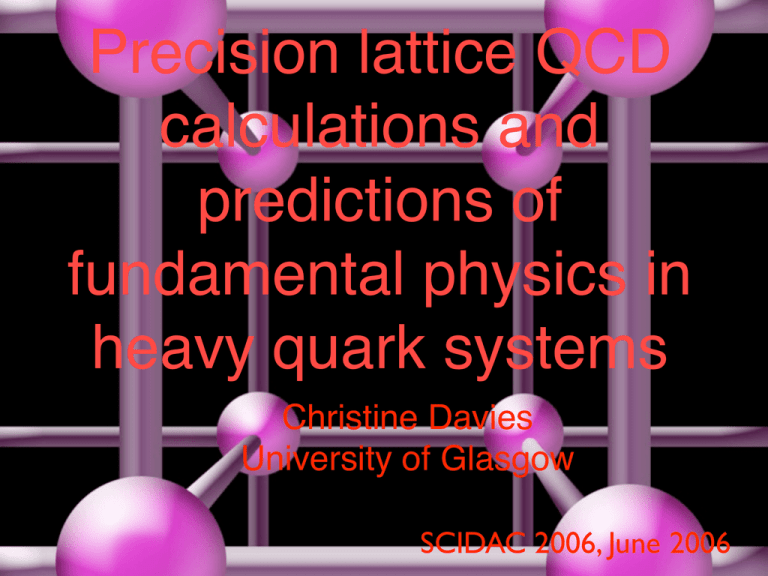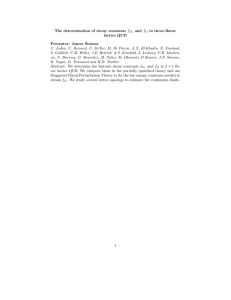B - USQCD
advertisement

Precision lattice QCD calculations and predictions of fundamental physics in heavy quark systems Christine Davies University of Glasgow SCIDAC 2006, June 2006 Particle physics: uncover the fundamental particles and interactions at the smallest distance scales ... Atom - nm Proton - fm Particle physics experiment Smashing protons together at high energy does not give subunits directly - just more particles! Protons and other hadrons are made of quarks interacting by the strong force. Quarks never seen as free particles - to study them need accurate expt and theoretical calculations. QCD is theory of strong force - hard to calculate because stronglycoupled and nonlinear needs numerical simulation. This is lattice QCD. Standard Model of particle physics has: ! "! "! " d s b 6 quarks u c t ! "! "! " e µ τ 6 leptons νe νµ ντ a ‘zoo’ of hadrons 3 forces (ignore gravity) : strong, weak, electromagnetic Over 20 parameters, whose origin is some deeper theory with New Physics. QCD is theory of strong force - mirrors QED Quarks electrons color charge RGB electric charge gluons photons BUT QED and QCD behaviour very different: QCD - gluons carry color charge - attempt to separate QED - uncharged photons qq , force becomes strong at travel freely - easy to get large distance and quarks and free electrons gluons confined. All info. about quarks indirect - from ‘colorless’ bound states, hadrons. Baryons = qqq e.g. p,n , mesons = qq qq Weir d t h in gs Rich spectrum of states Ge V masses calculable in QCD bb g bb qq if we can solve theory. bb !, A lot of states only exist briefly but can be seen in particle detectors and B bc properties determined. 12 11 10 b 9 8 7 c 6 B mesons B,B S 5 4 cc g cc , c 3 mp 2 Ch a rm e d mesons 1 Lig h t mesons 0 cc qq D,Ds glu eba lls qq g qqq q K, , The Meson Spectrum ‘Weird things’ not yet unambiguously seen. Theory can help to find them. Quarks also feel the weak force Key to understanding CP (matter-antimatter) symmetry violation in Standard Model. (New physics?) Vcb Vud Complex couplings between quarks of different flavor and W. 3x3 CKM matrix poorly known BUT quark weak decays occur inside hadrons. QCD effects are critical must calculate decays of B mesons in lattice QCD Lattice QCD • Solve QCD by numerical evaluation of path integral: Z −SQCD dAµdψdψe • make integral finite with a space-time lattice a • Importance sampling - make gluon configs - ‘snapshots of vacuum’ and propagate quarks through them. • ‘Measure’ e.g. hadron correlators on the gluon configs to calc. hadron masses and weak decay rates Handling light quarks is a big headache Lq,QCD = ψ(γ · D + m)ψ ≡ ψMψ For valence quarks, need to calc. M For sea quarks need to inc. det(M) in making gluon configs Very costly as mq → 0 Early calcs: Quenched Approximation - omitted sea quarks. This is not good enough for precision required. Need to unquench with real s and light u/d. −1 −6 Cost of lattice QCD calc. grows as a must work with largest spacing possible Discretisation errors are a big issue Derivs become finite differences: ∂ψ(x j ) ψ(x j + a) − ψ(x j − a) 2 = + O (a ) ∂x 2a Correct with higher order difference - but must take account of gluon radiation ‘Improvement’ gives much higher accuracy - results with sea quarks from ‘improved staggered quark QCD action’ -errors a few % at a=0.1 fm Life as a lattice QCD theorist Tbytes data Large analyses - 0.5-1 Tflopyears (Fermilab cluster) Generate configs - 1-2 Tflopyrs (QCDOC at Edinburgh) People time is important too! Small analyses and tests - Gflopyrs (Glasgow cluster) Take-home message • There has been a revolution in the numerical simulation of the theory of the strong force (lattice QCD) since 2003 • Lattice QCD now delivering results : hadron masses that agree with expt; precise parameters of QCD; decay rates needed to determine the CKM matrix accurately. Lattice QCD results MILC collaboration gluon configurations have: • 2+1 flavors of sea quarks, down to mu/d = ms/10 . • Many mu/d values; 2 ms values • 3 values of lattice spacing: 0.18fm, 0.12fm and 0.09fm 3 (2.5 f m) • Spatial volume exceeding so lattice size 283 × 96 QCD has 5 parameters : 4 quark masses and a bare coupling. Must fix these using ‘gold-plated’ (i.e. stable) hadron masses. FNAL/HPQCD/MILC/UKQCD analysis of MILC configs. Fix: a : Mϒ! − Mϒ mu/d : Mπ ms : MK mc : MDs mb : Mϒ Calculate other gold-plated hadron masses as test. Results that follow from this analysis (but not all configs). Summary of results Results including u,d and s sea quarks agree with experiment across the board -from light to heavy hadrons. Parameters of QCD are unambiguous fπ fK MΩ MΞ − MN 2MDs − Mηc 2MBs − MΥ ψ(1P − 1S) Υ(1D − 1S) Υ(2P − 1S) Υ(3S − 1S) Υ(1P − 1S) 0.9 1 1.1 LQCD/Exp’t (nf = 0) 0.9 1 1.1 LQCD/Exp’t (nf = 3) Quenched results are wrong and ambiguous Davies et al, hep-lat/ 0304004, Aubin et al, hep-lat/0407028, Toussaint+Davies, hep-lat/ 0409129, Gray et al, hep-lat/0507013, 2 α = g /4π Determining Parameters of QCD : s R g = color charge. Measure with ‘test charge’ at distance R. q R-dependence from vacuum polarization effects q q 2004 Nobel Prize In lattice QCD have g in action and ‘measure’ a. q q q q q q q q q sea quarks screen charge (in fact a bit harder than this to do accurately ...) gluons ‘antiscreen’ Lattice QCD result (5) αMS(MZ ) = 0.1170(12) 2004 PDG = 0.1187(20) R αV (nf ) (d/a) 0.8 0.6 nf = 3 0.4 0.2 Lattice result with sea quarks nf = 0 2 Quenched result 4 6 d/a (GeV) 8 HPQCD, Mason et al, hep-lat/0503005 mq Determining parameters of QCD: Quarks never free so cannot measure mass directly Masses are parameters in lattice QCD action determine by getting hadrons masses right. Convert to continuum mass by (hard) analytic calcln. (gives error) Quark masses (MeV) 2005 lattice QCD 2004 PDG 10000 b c 1000 m proton s 100 10 d u 1 HPQCD/MILC, Aubin et al, hep-lat/0405022; HPQCD, Mason et al, hep-lat/0511160 Lattice QCD prediction! : mass of Bc meson Using NRQCD formalism for b and FNAL formalism for c, calculate splitting Result: MBc = 6.304(20)GeV 6500 lattice QCD, Feb. 1999 lattice QCD, Nov. 2004 CDF, Dec. 2004 2 mBc (MeV/c ) 1 MBc − (Mϒ + MJ/ψ) 2 6600 Lattice systematic errors 6400 6300 6200 CDF (2005): 6.287(5) GeV HPQCD/FNAL /UKQCD Allison et al, hep-lat/0411027; CDF, Acosta et al, hep-ex/0505076, Behari here. Weak decay rates and the CKM matrix Vud Vus Vub W π → lν K → lν B → πlν Vub J = V0, Vi, A0, Ai K → πlν π Vcd B V V cs cb D → lν Ds → lν B → Dlν D → πlνD → Klν Lattice QCD calc. gives rate of Vtd Vts Vtb basic weak decay from one hadron to another. CKM and "Bd |Bd # "Bs|Bs# lepton kinematics outside calc. Lattice QCD can calculate decay rates for at most one ‘gold-plated’ hadron in final state. Possible for almost every element of CKM matrix. * Need multiple cross-checks of lattice calcs in different systems e.g. ϒ, B, D, ψ etc Determination of CKM matrix Vub B W J = V0, Vi, A0, Ai π weak decay of quark inside a hadron calculate in lattice QCD expt = CKM x lattice unitarity triangle sides Precision (3%) lattice QCD needed Key results from ‘B factories’ + lattice QCD B mesons - valence quarks: b + light Test lattice QCD by predictions for D (c + light). CLEO-c LP05 Leptonic decay rate of D from CLEO. Convert to fD given Vcd W B D FNAL/MILC/HPQCD 100 150 200 250 fD (MeV) 300 J=Aµ Lattice and CLEO agree but both have 8% errors - need to improve! FNAL/MILC/HPQCD Aubin et al, hep-lat/0506030; CLEO, hep-ex/0508057 New determination of fB, fBs W B J=Aµ Coarse lattice, Partially Quenched Coarse lattice, Full QCD Fine lattice, Full QCD Full QCD Staggered ChPT !(Bs) / !(Bq) 1.3 fB = 216(22)MeV 9% error from pert matching 1.2 f Bs = 1.20(3) fB 1.1 1 Previous lattice calcs 0.9 0 0.1 0.2 0.3 0.4 0.5 mq/ms 0.6 0.7 0.8 0.9 1 pert. error cancels. 3% from extrap. in u/d mass HPQCD, Gray et al, hep-lat/0507015; log dependence on light quark mass expected NEW Exptl result for Br(B → τν) from Belle, hep-ex/0605068 Neutral B mesons have fluctuating identity B/Bs oscillation rate determined by box diagram. Calculate in lattice QCD as 4-q operator. VtdVtb∗ B0 B0 = HW 2 fB BB Parameterise as where fB is decay constant. W B J=Aµ fBs/ fB is now calculated to 3% . BBs /BB expected to be NEW - measurement by 1, but not yet clear. CDF of Bs oscillations Constraints on CKM unitarity triangle Flavor Physics and CP Violation Conference, Vancouver, 2006 Using just B leptonic decay and B/Bs oscillations Mainly quenched + 2 flavors heavy sea clover New 3-flavor imp. stagg except for quenched B onstraints on the ρ − η plane derived from B meson leptonic decay and BB mixing. The bounds y clover fermions, those on the right employ staggered. B CKMfitter group, FPCP 2006 Semileptonic form factors B → πlν and Vub Vub W B J = V0, Vi, A0, Ai π 3 2.8 Flavor Physics 2.6 previous f+ and f0and CP Violation Conference, Vancouver, 2006 2.4 new f+ 9] 2.2 in blue., new f 0 2 1.8 fBs /fB = 1.20(3)(1), (2) 1.6 1.4 error is from chiral extrapolation first and + 1.2the second is from everything else. This and 1 with the result that JLQCD found mpared 0.8 extrapolating from a much larger hirally ss:0.6 fBs /fB = 1.13(3)( +13 −2 ). [8] 0.4 , HPQCD quotes 0 0.2 f0Bs = 0.260(7)(26)(9) GeV. (3) 0 10 20 5 15 25 2 2 q (GeV rtainties in fBs /fB and fBs )are relatively Predict D form factors f f HPQCD form factor gives: ent of each other, since the uncertainties in r are dominated by statistics and chiral ex−3 n, while the uncertainties in the latter are Figure 2: The predictedHPQCD. shape ofhep-lat/0601021; the form factor for ub d by everything else. fBs /fB is more indeFNAL/MILC, hep-lat/040830; D → Klν has been tested with increasing accuracy by 12% error from lattice f f8% than of f . Bs B hep-ex/0510003 experiment, most recentlyBelle, by Belle [13]. error from expt V = 4.22(30)(51) × 10 Conclusions • Accurate Lattice QCD calculations are now maturing. Tests of hadron masses and determination of parameters of QCD are at the few % level. Future • 10% errors on decay matrix elements for CKM. Beat down errors further and finish B oscillation calc. for impact on unitarity triangle. • Longer term - work on harder calculations e.g. for proton structure and unstable particles. • Calculations beginning now that use other quark formalisms that are numerically more expensive.
